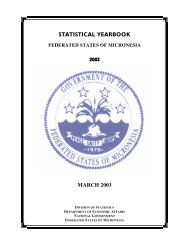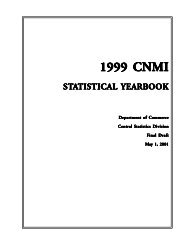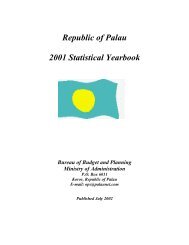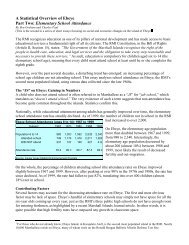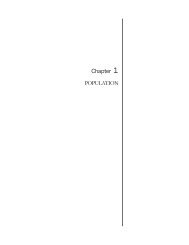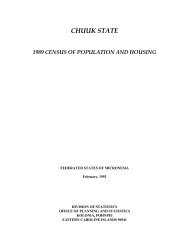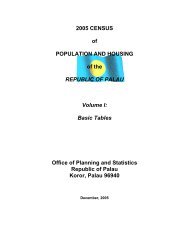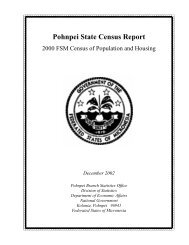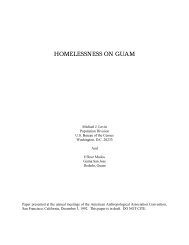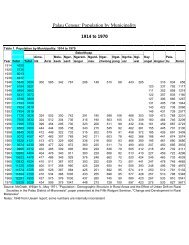Chuuk State Census Report - pacificweb.org
Chuuk State Census Report - pacificweb.org
Chuuk State Census Report - pacificweb.org
You also want an ePaper? Increase the reach of your titles
YUMPU automatically turns print PDFs into web optimized ePapers that Google loves.
Chapter 4. Fertility2000 FSM <strong>Census</strong> of <strong>Chuuk</strong> <strong>State</strong>The technique used took advantage of the relative strengths of two approaches. Using the ratio of births estimated fromreverse survival to the mothers reporting a birth as a correction factor retained the age specific pattern of fertility, andfixed the level of fertility based on the more plausible reverse survival estimate of births.The fertility pattern illustrated in the last column of Table 4.4 appears very smooth. The low rates at ages 15 to 19reflect the delay in childbearing due to a later age of marriage discussed in Chapter 3. In 2000, the peak fertilityreached at ages 25 to 29 with 0.197 children per women, whereas. in 1994, the peak was at ages 30 to 34, with 0.241children per women. While age specific fertility falls quite sharply after age 35, the slope is not sufficiently steep tosuggest an extensive use of family planning. For example, in 2000 women ages 40 to 44 continued to bear on average0.074 children each year.The ASFRs provide too much detail to be practical for some comparisons. A very useful composite index is the totalfertility rate (TFR), which effectively sums the current age specific fertility for each year of a woman's reproductivelife. The TFR thus provides a measure of the average number of children a woman would bear under a given scheduleby the end of her childbearing years. Computation from the ASFRs is relatively simple, involving the summing ofannual age specific rates. The rates provided in Table 4.4 would yield a TFR of 4.1. Given the fertility levels in 1999-2000, each <strong>Chuuk</strong> woman would give birth on average to 4.1 children during her reproductive lifetime. However, theresults of the reverse survival method are slightly lower than the result of the second method using the indirect P/F ratioshown below.The P/F ratio method of estimating fertility compares the reported historical fertility (parity) of women to the currentfertility of the same women and establishes a correction factor to apply to the ASFRs to calculate a more precise TFR.The correction factor adjusts for under-response and poor recollection of fertility data by older women who mightunder report births. Once the difference in reported parity and fertility is found, the under count can be corrected. Inthe case of <strong>Chuuk</strong>, a correction factor of 1.18 was chosen to correct the ASFRs and gave an adjusted TFR of 4.5 (seeTable 4.5). The correction factor was an average obtained from the P/F ratio that applied to women aged 20 to 24 and25 to 29. and that of the reverse survival, to average out the fluctuation caused by reporting errors and declining fertility(see United Nations Manual X, "Indirect Techniques for Demographic Estimation"). The increase in the P/F valuesuggests that there is a growing disparity between current fertility and parity and supports the conclusion that currentfertility is lower than previous fertility, or fertility is still declining.Table 4.5: Calculation of Total Fertility Rate with P/F Ratio, <strong>Chuuk</strong> <strong>State</strong>: 1994 & 20001994 2000Children Age- Summation Parity Children Age- Summation Parityever specific of ASFRs Adjust- divided by Adjusted ever specific of ASFRs Adjust- divided by Adjustedborn per fertility multiplied ment adjusted ASFR born per fertility multiplied ment adjusted ASFRwoman rates by 5 of phi phi by factor woman rates by 5 of phi phi by factorAge groups (Parity, P) (ASFR, fi) (Phi) (F) (P/F) of 1.28 (Parity, P) (ASFR, fi) (Phi) (F) (P/F) of 1.1815 to 19 years 0.086 0.026 0.131 0.105 0.820 0.034 0.075 0.028 0.139 0.053 1.410 0.03320 to 24 years 0.651 0.126 0.764 0.475 1.371 0.162 0.630 0.139 0.835 0.522 1.207 0.16425 to 29 years 2.042 0.194 1.736 1.334 1.530 0.249 1.586 0.187 1.770 1.386 1.144 0.22030 to 34 years 3.664 0.202 2.748 2.355 1.556 0.260 3.072 0.183 2.687 2.335 1.316 0.21535 to 39 years 5.061 0.160 3.547 3.222 1.571 0.205 4.443 0.137 3.373 3.118 1.425 0.16140 to 44 years 6.279 0.119 4.145 3.909 1.606 0.153 5.575 0.070 3.724 3.585 1.555 0.08345 to 49 years 6.734 0.040 4.346 4.603 1.463 0.051 6.238 0.024 3.842 3.815 1.635 0.028TFR ... 4.35 ... ... ... 5.57 ... 3.84 ... ... ... 4.52Source: 1994 & 2000 FSM <strong>Census</strong>es, unpublished dataThe CBR suggested declining fertility over the 27 years before the 2000 census; adjusted ASFRs showed a similartrend falling from over 8 children per mother in 1973 and 1980 to 6.8 in 1989, declining to 5.6 in 1994, and furtherdeclined to 4.5 in 2000 (see Table 4.6). The high fertility levels in 1973 and in 1980 were probably a reflection ofchanging health conditions in <strong>Chuuk</strong>. In 1973 and 1980 public health services had brought down child mortality, butwomen were still having large families to replace those children who potentially would not survive.38 <strong>Chuuk</strong> Branch Statistics Office, Division of Statistics, FSM Department of Economic Affairs



